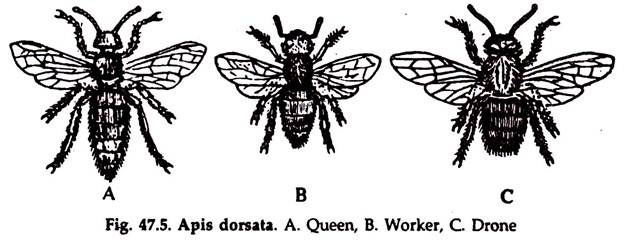In this article we will discuss about:- 1. Meaning of Apiculture 2. Methods of Bee-Keeping in India 3. Tools 4. Typical Location 5. Diseases.
Meaning of Apiculture:
Bees are economically important social insects. They not only provide us with honey and wax, they are also responsible for pollination of flowers of the majority of damaged bee larvae, pollen grains, etc. of commercially important plants. The common Indian honey bees are Apis (Megapis) dorsala (Fig. 47.5), A. (microapis) florea and A. indica.
Apiculture or bee-keeping is the technique of rearing honey bees for honey and wax from their comb or beehives. Selection of sites for quality honey and protection of bees and combs from pests and diseases are part of apiculture.
Methods of Bee-Keeping in India:
ADVERTISEMENTS:
1. Indigenous methods:
a. Immovable structures:
It is practiced in villages from time immemorial. Small structures are made in secluded and protected places. During construction of dwelling houses, small permanent chambers are made in the outer wall of the house for bees to build combs. Sometimes mud chambers are constructed.
On the outer-side of the chamber a horizontal slit is made for the entry of bees, while on the inside wall a large opening is left for removal of comb.
ADVERTISEMENTS:
b. Movable structures:
Bee chambers are made up of hollow bags, empty wooden boxes, earthen pots, etc. which can be moved from place to place, and put in a suitable location for the bees. These methods are not much satisfactory, as the comb is lost in the process of extraction of honey. The quality of honey is inferior due to presence of dust, tissues of damaged bee larvae, pollen grains, etc., in it.
2. Modern methods:
Beehive:
ADVERTISEMENTS:
In modern apiary, Longs troth’s frame hive is most suitable and used commercially for production of honey.
1. It is a two-tier structure. The chambers can be removed from or added to, as required.
2. The hive is made up of wooden box.
a. It has a basal plate or bottom board on which is placed a wooden box called brood chamber.
b. A small opening at the bottom of brood chamber permits passage for bees.
c. Inside the brood chamber several frames hang vertically from the top. These frames can be removed independently. For this arrangement, a modern hive is also called movable frame hive.
d. The distance between the two frames, the bee space is narrow and serves as a passage for the workers but small for building a comb.
e. Above the brood chamber is placed another similar chamber, but of lesser height.
f. It is meant for storage of honey only and known as honey chamber. The queen is never allowed to enter the chamber. In some cases two honey chambers are used.
ADVERTISEMENTS:
3. Above the honey chamber an inner covering is placed over which lies the roof.
Tools for Bees Keeping:
1. Comb foundation:
A small piece of comb is necessary to tie with one of the frames from where the bees will start comb-building.
2. Bee gloves:
Leather gloves are used to prevent bees from stinging during handling of the comb and bees.
3. Bee veil:
A bee veil is required to cover neck, face and head of the keeper during handling. Usually it is made of linen.
4. Smoker:
A smoker must be used while capturing bees in a hive. Smoke from paper, wood and coconut cover makes the bees inactive. There is fire box in a smoker in which smoke-producing materials and fire are put. A bellow system is fitted to blow the smoke.
5. Hive tool:
It is a long, narrow and flat piece of steel with a slightly bent head to scrap away dirty materials deposited by bees or some other factors.
6. Honey extractor:
It is used for extraction of honey from the frames without damaging the comb. It consists of a metal drum with several pockets around a rotating wheel. The frames are hanged from the pockets and the pockets are made to rotate round a central axis.
The centrifugal force created by rotation separates honey from the comb which is collected in the drum. The honey is taken out from the drum through a hole at the bottom.- The combs and frames are again placed in the hive.
Typical Location of Apiary:
A locality for apiary must have different varieties of pollen and nector-producing plants in sufficient number within a distance of 1.5 to 2.5 km. area. Neem, Rita, Tamarind, Cheery, Apple, and Citrus, Lily, Lotus, various wild plants and crops are good sources for both nectar and honey.
Diseases of the Bees:
Bees suffer from different contagious diseases and are very often subjected to curious organic disorders. The organisms for contagious diseases are Aspergillus, viruses, mites and Protozoa.
a. Aspergillus, a fungus, causes paralysis in worker bees.
b. Virus cause paralysis and high percentage of mortality to all categories of bees.
c. Gut protozoa, particularly Nosima apis, cause death of bees.
